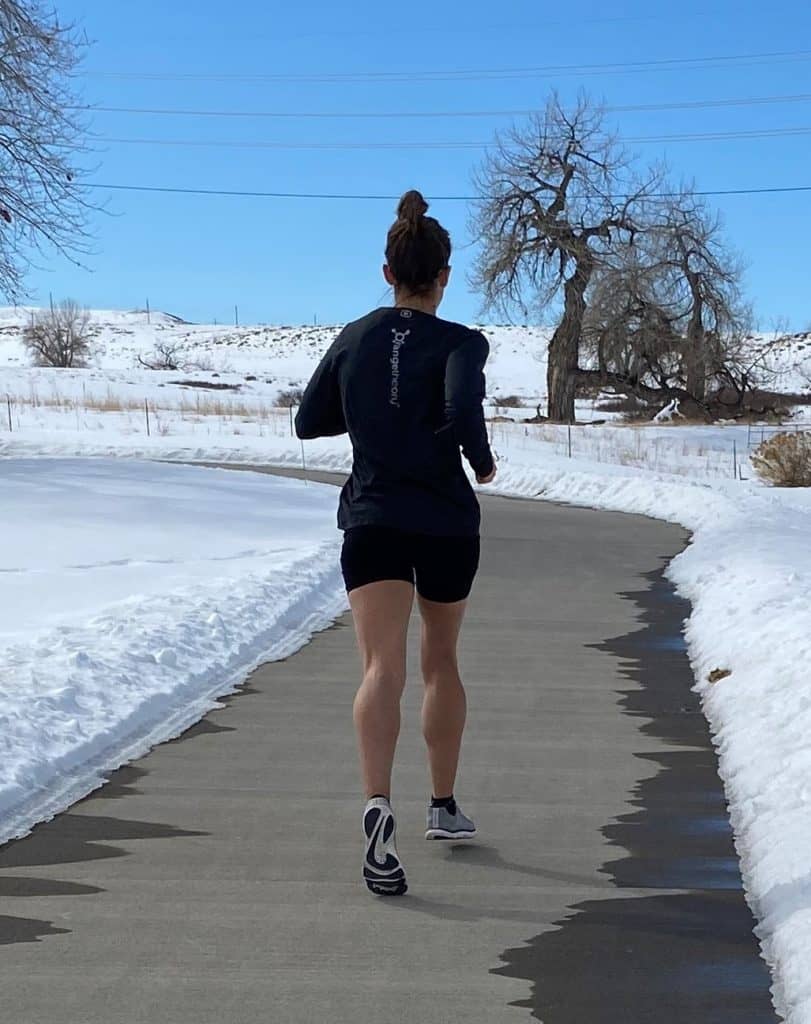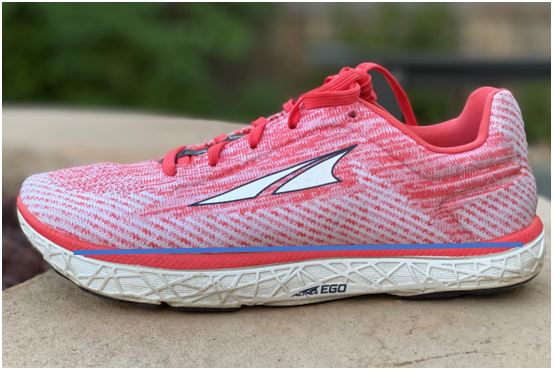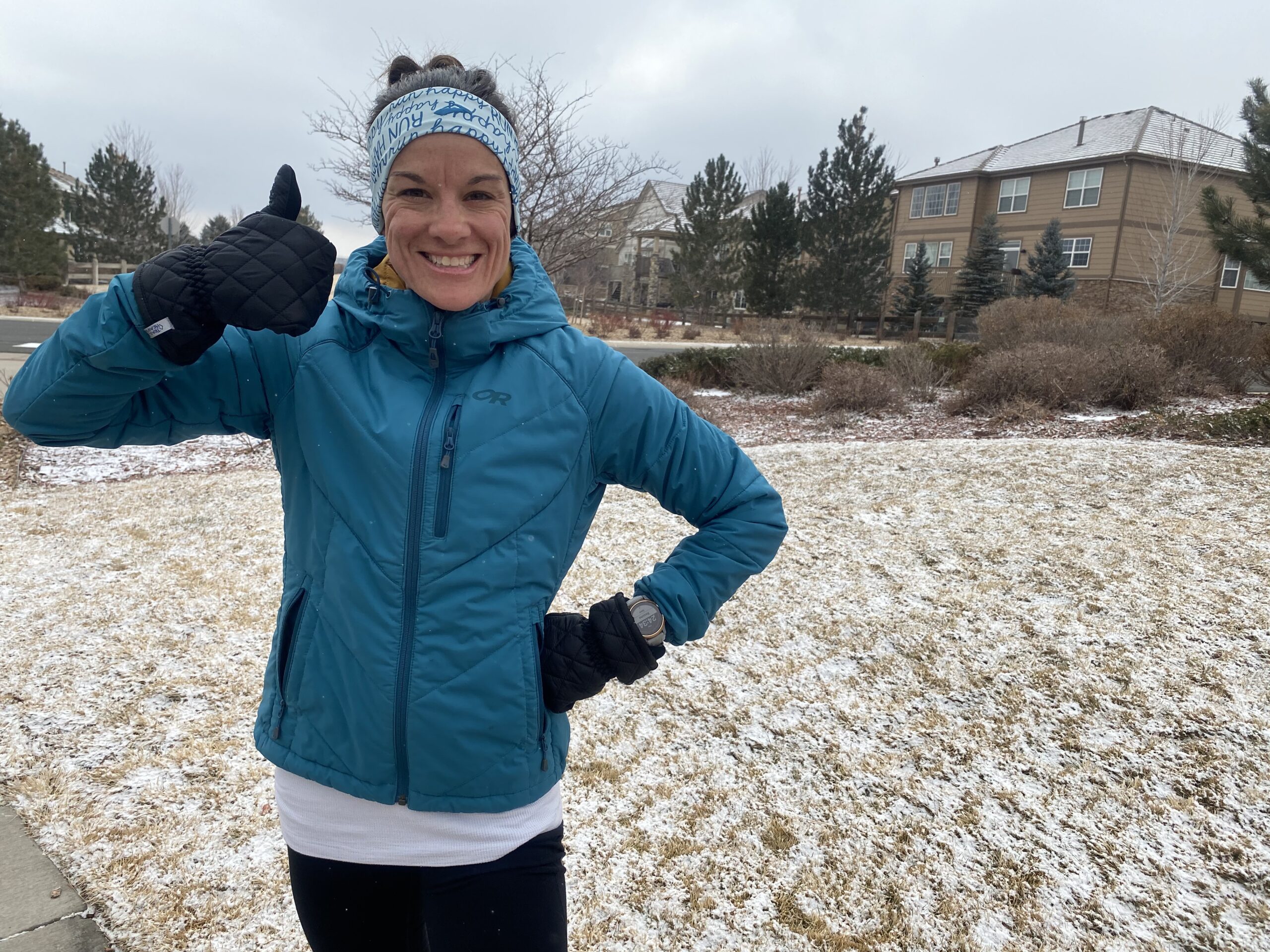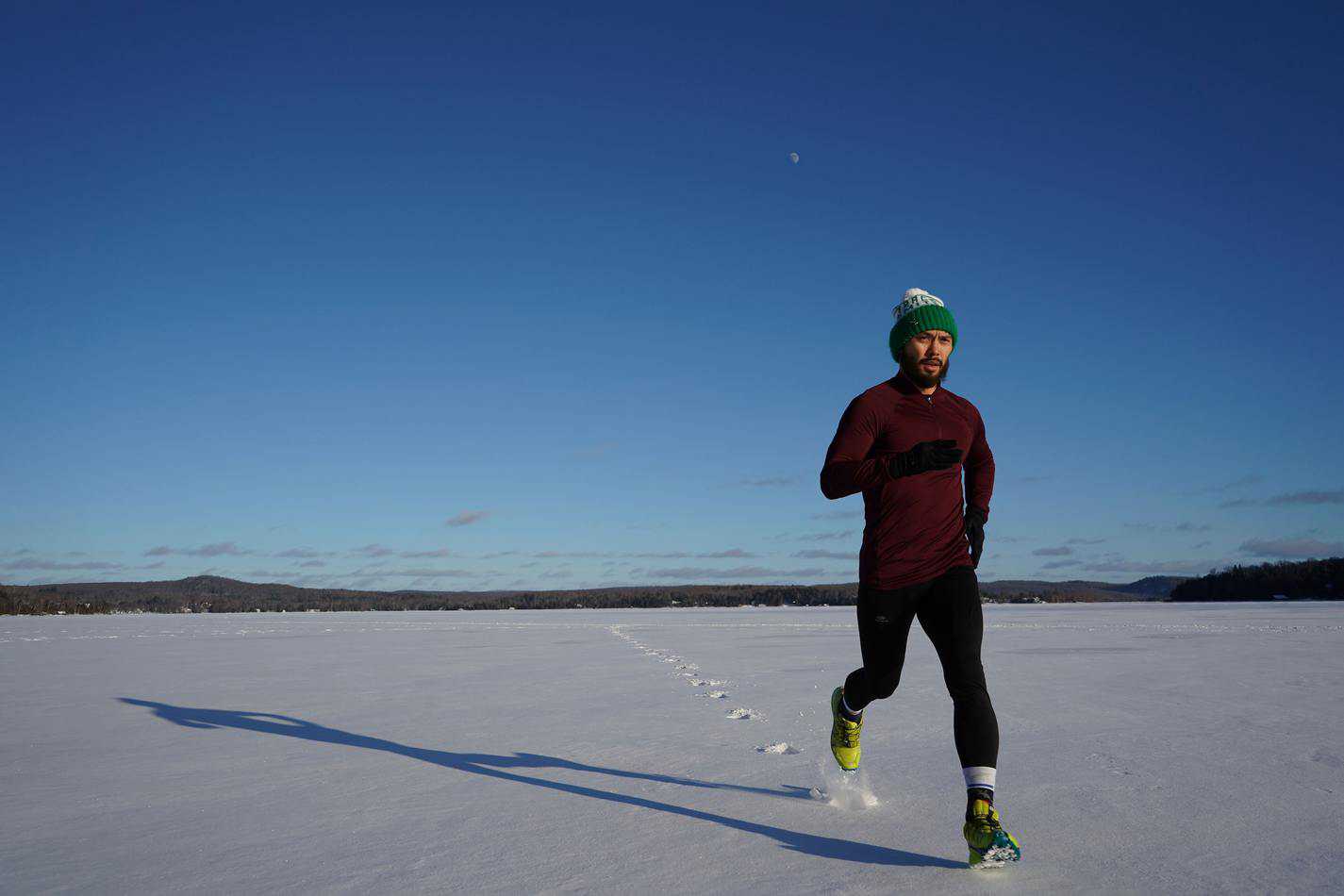Even when you think you’ve finally found a pair of running shoes that’s working for you, when someone mentions the “next best thing” you listen, right? You’re apt to get on board if someone can convince you this is the pair that will give you all the miles and the fastest time. Perhaps you’ve recently heard someone mention zero drop running shoes and you’re wondering if these are the “it” shoe that you need.
No running shoe is one-size-fits-all, but what if you’re missing out on the shoe that will help you take your running to the next level? Because we believe in giving you all the deets to make an informed decision, today we’re going over zero drop running shoes including what they are, what they’re not, and if they can make you a better runner.
What are zero drop shoes?
“Zero drop” refers to balanced cushioning from the back of a running shoe all the way to the front, and was coined by Altra creators, Brian Beckstead and Golden Harper. When you stand flat in the shoe, your heel is the exact same distance from the ground as your forefoot. The heel-to-toe drop, as it’s referred to in the running shoe world, is 0 mm.
You can find no drop shoes in various styles, but in this article we’ll be focusing on no drop running shoes, both for the road and trails.
Now you may be thinking that most running shoes look fairly flat from back to front, and that is true for many. In fact, a typical heel-to-toe drop of a running shoe is only around 10 mm. So at one centimeter, it doesn’t seem like much and you probably wouldn’t even notice if you weren’t looking for it.
But once you have this knowledge, you’ll start to notice the slight difference in various pairs of running shoes.
One confusion about zero drop is whether or not they’re the same as minimalist shoes. Are they?
Are zero drop shoes the same as minimalist shoes?
The term “zero drop” is often used interchangeably with “minimalist.” For example, this article from Well + Good quotes a podiatric surgeon who states, “Zero-drop running shoes are minimal ‘barefoot’ running shoes that have minimal to no cushioning.”
But that isn’t always true.
Minimalist running shoes are *one type* of zero drop running shoes, but there are also plenty of cushioned zero-drop shoes.
A shoe can have an inch of cushioning underneath the sole but still be zero-drop since we’re only measuring the drop from the back of the shoe to the front. The Altra Torin is a perfect example of this. With a stack height of 28 mm, it’s far from a minimalist shoe.

On the other hand, the Merrell Vapor Glove is an example of a zero drop shoe that IS also minimalist…with a stack height of only 6.5 mm.
To summarize: Zero drop shoes can be minimalist or maximalist and everything in between as long as the heel and forefoot are an equal distance from the ground.
Runners looking for zero drop shoes can find them in various levels of cushioning to suit their needs. Because zero drop doesn’t mean a lack of cushioning, we are focusing on why you might choose shoes that put your foot in a flat position instead of at an angle.
Benefits of Zero Drop Running Shoes
Of course you want to know, are zero drop shoes good for running?
We’ll go over that – first a backstory on how I started running in them.
Before I transitioned to wearing zero drop shoes, I had begun to see the brand Altra more and more. I had no idea they were really any different than any of the other brands of running shoes until I attended a running clinic at my hometown Orangetheory.
During that clinic, the coach was teaching runners the benefits of running with a midfoot or forefoot strike instead of utilizing a heel-toe strike as most runners do. He had the heel strikers (most everyone) try running with a midfoot strike on the treadmill and it did not feel at all normal for me. But when he mentioned how it could reduce impact and stress on the body as well as increase running cadence and perhaps make me faster, my interest was piqued.
After class I asked how I could get started toward a midfoot/forefoot strike, he mentioned his shoes. Altras. He told me they were zero drop and would help force me to run with this new form I was ready to try.

So let’s talk about some of the benefits of using zero drop shoes, including some of those mentioned by my coach that day.
Some benefits of wearing zero drop shoes include:
- Help with low-impact landing – Heel striking causes a greater amount of force on the body (legs, knees and hips) than midfoot or forefoot striking. This article from Vertex PT Specialists found that “the increased force exposure and absorption may increase a heel strike runner’s risk for general joint pains and bone stress injuries compared to forefoot and midfoot runners.” Though altering your foot strike with zero drop shoes isn’t the only way to decrease this force, it does help.
- More natural foot position – When you walk barefoot, your feet are flat. From the time you learn to walk, your body is used to walking with your entire foot in alignment. Ever try to run heel-to-toe with bare feet? You really can’t – at least not fast or without hurting yourself. Because of this, you’ll find heavily cushioned heels on running shoes to protect the back of heel strikers’ feet.
- They are often lighter in weight – In my article, “Running Shoe Weight and How to Choose the Best Option” I talk about some of the advantages of wearing a lighter shoe, and if you want to go fast, lighter is almost always better.
- Increased running cadence – Running cadence is the number of times your feet hit the ground in 1 minute. Increased running cadence can lead to increased speed. Though there are plenty of heel-strike runners who have a high cadence, running with a midfoot or forefront strike forces you to shorten your stride to get a quicker turnover.
- Naturally shortens your stride – Heel strikers are notorious for overstriding (though not all of them do). Overstriding causes a runner to land harder on the ground which puts a runner at a higher risk for injury. It’s also a common culprit for low running cadence. Utilizing zero drop shoes promote a strike closer to the front of the foot, in turn improving stride and cadence.
Altra Running was built on the notion that both the heel and forefoot shoe be at an equal distant from the ground since that’s really the way we were born to walk and run. They write,”This natural foundation aids in optimal alignment, cultivates better form, and encourages a low-impact landing.”
Are there drawbacks to zero drop shoes?
As someone who used to be a really bad heel striker, one of the main reasons I switched to forefoot striking in a zero drop shoes was a way to stay a lifelong runner.
Though I wasn’t necessarily nursing specific injuries at the time, I felt like the blunt force of heel striking was slowly breaking down my body. Looking back now, overstriding was just as much of a problem as the heel striking, but running in zero drop shoes seemed like a good way to correct both issues.
With that said, zero drop shoes aren’t for everyone. There is a learning curve involved in transitioning to this type of shoe. (However, if you are already a midfoot or forefoot striker in a typical drop shoe the transition time will be less significant.) And transitioning to zero drop shoes too fast without listening to your body can also be problematic (read on to find out how to acclimate correctly.)
Otherwise, there really aren’t any cons per say to running in zero drop shoes, but people shouldn’t feel pressured to switch if what they are using is working.
Will every runner benefit from a zero drop shoe?
Not every runner needs to run in zero drop shoes to reach their potential. There’s no sense in debating if zero drop shoes are better or not…they are simply better for some! Including me.
The benefits that zero drop shoes can offer doesn’t necessarily mean you’ll ONLY get those benefits from that type of shoe. There are many other factors, for example, that can lead to injury, that it’s not always the shoes that are to blame. PodiatryToday quoted a study that looked at injuries in runners using shoes with similar stack height but different shoe drops (10 mm, 6 mm and 0 mm). They wrote, “This Level I study showed that shoe drop did not affect the rate of injury in runners.”
Ultimately, I’d say, do your research and if they sound like they’d make you a better overall runner than give them a try.
I know I’m thankful I made the switch. Though I’d be remiss if I wasn’t up front in saying that the switch wasn’t without work.
Acclimating to Zero Drop Shoes
If you’re ready to start running in a pair of zero drop shoes, you’re going to need to take some time to get used to them. If you have a race coming up, this is not the time to make the switch.
If you don’t heed this advice, you’ll likely sabotage your race, end up with an injury, or both. Switching to zero drop shoes is best done in your off-season or at the very beginning of a new training season.
A 12 mm drop difference from heel-to-toe in the popular Brooks Ghost 12 may seem like a miniscule change from a 0 mm drop, but I promise you will immediately notice the difference. Making the switch to a zero drop shoe, for many, means making a commitment to completely changing the way you run.
So how do you acclimate to a zero drop shoe when moving from a running shoe with the more typical 10 – 15 mm difference?
Top Tips for Transition to Running Shoes with No Drop
1.) Drop your mileage – By a lot. When in the middle of the switch to zero drop shoes, less is more. Even just 2-3 miles will bring new fatigue to your tendons, ligaments and muscles of your legs that you’re not used to. So run a couple of miles and see how you feel the next day. If you feel any new soreness, rest and heal up and allow the discomfort to subside before running again. Remember that the inflammation you feel is necessary for healing your injury and ultimately making you stronger.
2.) Run less days in a week – Not only do you want to drop mileage, but you’ll also want to run fewer days. Putting a rest day between each running day is the best way to go initially (and more if necessary).
3.) Slow down – Approach runs in your new shoes like you would a recovery run. Easy, conversational-paced miles will help you minimize new soreness.
4.) Alternate between your old shoes and your new, zero drop shoes – No need to go cold turkey when you transition to zero drop shoes unless you want to. Alternating between your old and new shoes/running form will allow you to make a smooth transition.
5.) Utilize calf-strengthening exercises. While transitioning to zero drop shoes, any type of strengthening you can do for your calves will help. The video below gives a great example of something simple you can do to complement what you’re doing out on the road.

After my coach recommended that I change my footstrike and start wearning zero drop shoes, I admit I was skeptical. I also didn’t want to go back to square one with my running. But I was confident that the work to get there would pay off, and I was right. I recommend Altra zero drop running shoes to everyone I know (Escalantes, especially are my favorite!)
Not only am I a healthier runner in zero drop shoes, in my 40s, I’m also the fastest I’ve ever been. Is it the shoes?
Best Zero Drop Running Shoes
Now that we’ve gone over all there is to know about zero drop shoes and how to safely transition into a pair, let’s look at a few top pairs! (It won’t take long for you to notice a theme…)
Each option comes in both men’s and women’s.
Best Zero Drop Training Shoe
These are by far my favorite running shoe. Though it’s good to rotate between shoes for different types of runs, this can be hard when you have a pair you really love! This is how I feel about the Escalantes. Mile after mile of marathon training and they never let me down. I also have several friends who work in the medical field who even wear these for long work days on their feet. They’re that amazing! The Torin is another option that many other Altra runners love.
Best Zero Drop Trail Shoe
The best way to force myself to rotate shoes is to hit the trails. Which I love to do, they’re just a bit harder to get to. When I run the trails, I love wearing Altra Lone Peaks. They are a versatile year round trail shoe that provides the perfect amount of traction. We listed them as one of our favorites in our article, “Best Shoes for Running on Ice and Snow,” because they are also waterproof. If you’re looking for a zero drop trail running shoe that you can hike in and also wear to run on icy roads come winter, this is it!
Best Zero Drop Racing Shoe
The Escalante Racer is similar in look and feel to the original Escalante, but is lighter and specifically designed for performance. If you have a race coming up, I think these could be your jam!
I also love this Shoe Finder from Altra that will help you figure out which shoe will work best for you. And just a tip: If you don’t mind wearing earlier models of their shoes, you can often find them for a great deal on Amazon.
Best Minimalist Zero Drop Shoe

Ok, stepping away from Altra for this one since Altra is known for a zero drop shoe that actually has cushioning. If you’re wanting more of a barefoot running experience but with some protection for your feet, the Vapor Glove from Merrell gets excellent reviews, and you can choose between the sneaker and trail shoe.
Love the idea of zero drop shoes, but don’t want to give up your old pair just yet? Having a pair of zero drop shoes to run in doesn’t mean that you’re committing to only zero drop shoes. My husband alternates between the zero drop Altra Solstice for faster runs and the Brooks Ghost 12 (12 mm drop) for easy runs and loves them both!
FAQ About Zero Drop Shoes
Are zero drop shoes good for walking?
Zero drop shoes are great for walking. And unlike running, you can transition to them without an adjustment period since everyone naturally walks heel-to-toe. They’ll definitely feel different, but are well suited to walking since our feet are used to being flat when we walk barefoot.
Are Hoka runnng shoes zero drop?
Hoka running shoes are not zero drop running shoes, but they are much closer than many other popular running shoes. Most Hoka shoes have a 4-5 mm drop.
Does Nike make a zero drop shoe?
I had this question, too, so I’m happy to share what I found. Though I did see the Nike Flex Fury 2 listed on sites as a zero drop shoe, it’s actually not. At 6 mm, it’s minimal, but still more than Hoka and not zero drop. The Nike Free RN also has a 6 mm difference.











